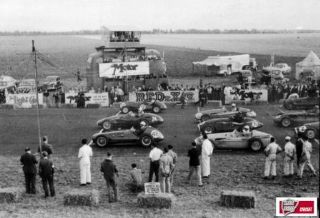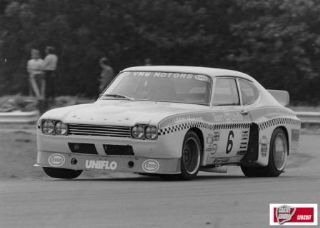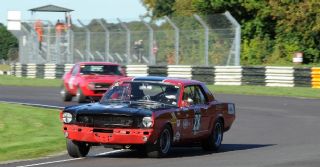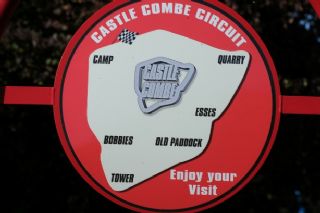The Castle Combe Circuit By Peter Stowe

October 1955 Hastings Trophy Formule Libre front row: Ron Flockhart - BRM V16, Harry Schell - Vanwall, Bob Gerard - Cooper-Bristol (Image: Castle Combe Circuit Ltd)
Castle Combe Circuit in north-west Wiltshire is one of the longest established in the UK, having first opened in July 1950. During the following six decades many famous names from British racing history, including future World Champions from Mike Hawthorn to Damon Hill, have appeared at the track, in company with most of the well-known names of British motor racing of the period.
Created by the local Bristol Motor Cycle & Light Car Club, with the enthusiastic support of the landowner, Kay Thomas, the circuit follows the 1.84-mile perimeter road of the former RAF training aerodrome that had been constructed on open farmland to the east of Castle Combe village during World War 2.
The first, low-key, club meeting in July 1950 saw David Wilkins win the first ever race, on a 500cc Triumph clubman’s motorcycle, and Jim Sparrowe (Morgan) the first ever car race. In October that year the first national meeting was held and a young Stirling Moss won a trio of races in an HWM single-seater, a sports Frazer Nash and a Cooper 500.
Over the next few years Mike Hawthorn won four times in his Riley sports cars; Colin Chapman gave the Lotus Mk3, his first pure circuit racing design, a winning debut; and in 1955 Graham Hill had one of his very first races, in a C-type Jaguar. While Stirling Moss enjoyed further successes, on his final visit in 1953 his Cooper was clipped from behind at Quarry corner and rolled, and he sustained a broken shoulder. Appearances of the ear-splitting BRM V16’s in the hands of Ken Wharton and Ron Flockhart are still well remembered by older spectators, while a local star was Bristolian Horace Gould in a Cooper-Bristol and F1 Maserati 250F. In October 1955 the 100-mile Avon Trophy International Formula 1 race was won by American Harry Schell in the Vanwall.
That was, though, the last car race meeting at Castle Combe for several years. The small Bristol club could not afford the additional safety improvements required following the Le Mans disaster and car racing ceased, although the circuit continued to be a popular motorcycle racing venue. However, in 1962 the BRSCC funded the work needed to create a safety bank of earth around the track, and car racing began again.

1976 Vince Woodman - Ford Cologne Capri (Image: Bill Riley/Castle Combe Circuit Ltd)
The 1960s was a busy time for the track with numerous club race meetings. Local stars included Ron Fry with his Ferrari 250GT Berlinetta and 250LM and later Ford GT40s; Terry Sanger with ‘Fraud’ Cortina V8 and Ford Falcon saloons; Jem Marsh and Geoff Mabbs in a Marcos; and Vince Woodman in his Lotus Cortina. In October 1965 Chris Summers recorded the Circuit’s first 100mph lap (101.59 mph) in his Lotus 24-Chevrolet V8, while future international stars such as Piers Courage (Lotus 7), Vic Elford (Lotus Cortina), and Derek Bell (Formula 3 Brabham) also appeared.
1967 saw the start of Formula Ford, with the second ever race being held at ‘Combe’ that July (winner - Dan Hawkes), and that was the beginning of a long-standing association with the Circuit. While the national Formula Ford series have seen irregular visitors over the years, it is the local, hotly-contested FF1600 championship, begun in 1969, that is still a major feature of circuit meetings.
In the late '60s trouble was brewing off-track, though, as planning permission was running out and local objectors were fighting against its renewal. After a planning enquiry, notice was served that the Circuit should close at the end of 1971.
In the meantime John Webb’s Motor Circuit Developments took on management of racing at the Circuit, and the next two years saw some high spots in its history with the appearance of some high profile series. In 1970 and ‘71 Peter Gethin (McLaren) and Frank Gardner (Lola) won European Formula 5000 championship rounds, while F3 races starred Alan Jones, Jody Scheckter, Jochen Mass and Roger Williamson.
Despite operating under temporary planning permissions the Circuit continued with a limited number of race meetings during the early 1970s. Then, in 1976, with the support of landowner Kay Thomas, it was bought by a consortium led by Howard Strawford. That September the first meeting under Castle Combe Circuit Ltd. saw Nigel Mansell (Hawke DL11), win the Formula Ford race.

The Wayne Langridge Mustang - 2012 Autumn Classic
In February 1981 the long fight for the Circuit’s future came to a head with a three-day public inquiry before a Department of Environment Inspector. James Hunt appeared as an expert witness in support of the Circuit, and the outcome was permanent planning permission for racing. With the future secure, long term improvement of the venue could now begin.
As the circuit developed through the 1980s and 1990s future Grand Prix stars such as Ayrton Senna (who dominated the British Formula Ford 2000 championship race in July 1982, beating the previous class record on every flying lap), Martin Brundle, Damon Hill and David Coulthard appeared as they made their way up through the junior formulae. The backbone of the Circuit’s meetings, though, came from their own popular championships, as it still does today. The long running FF1600 championship (with multi-champion local stars such as Bob Higgins and Kevin Mills) was joined by a Special GT series (now in its 30th year), and from 1995 a very popular saloon car championship.
Throughout this time, the infrastructure and spectator facilities were continually improved, the track completely resurfaced, and the pit lane widened, but the Circuit layout still followed the original RAF perimeter road. Lap records had increased from Chris Summers’ 100mph in 1965 to 120 plus by the mid-80s. Then, in August 1997, Nigel Greensall raised it to 130.93mph (50.59 seconds) in his Boss F1 Tyrrell 022-Judd, a mark that will stand for all time as in 1999 the circuit was revised to include two new chicanes, increasing the length to 1.85 miles.
Moving into the new millennium, further improvements allowed the circuit to host international events again. The British Formula 3 and GT championships appeared between 2001 and 2005, the F3 series including future Grand Prix drivers such as Anthony Davidson, Nelson Piquet Junior, Bruno Senna and Heikki Kovalainen. Unfortunately, some of the GT teams paid little respect to the silencing regulations, and eventually a Noise Enforcement Notice was served. Though the circuit appealed it, the case was lost in the local magistrate’s court and the F3/GT days were over.
In 2006, following a thirty-year association with the BRSCC, the Castle Combe Racing Club was formed to take over race meeting organisation, although in essence it was the same experienced and efficient team of officials and marshals in charge. In the summer of 2010 the Diamond Anniversary meeting celebrated 60 years of racing with David Smithies and Chris Clarkson winning the Ron Fry Trophy race in an Austin-Healey 3000.
For 2012 the programme of racing has included a mix of the home circuit championships along with visiting series, including HRDC historics and CSCC classics, and the season came to a climax during the weekend of 6-7 October with the Autumn Classic/Finals weekend. The Autumn Classic meeting on Saturday 6 October included the-Healey, pre-1966 Jaguar, VSCC pre-war sports cars, FISCAR and HRV8 races.
Full details of the Circuit’s story are contained in a comprehensive history, published in 2010: Castle Combe Circuit – The First 60 Years by Paul Lawrence and Peter Stowe, Published by TFM Publishing Ltd. (ISBN 978 1 903378 74 8).









